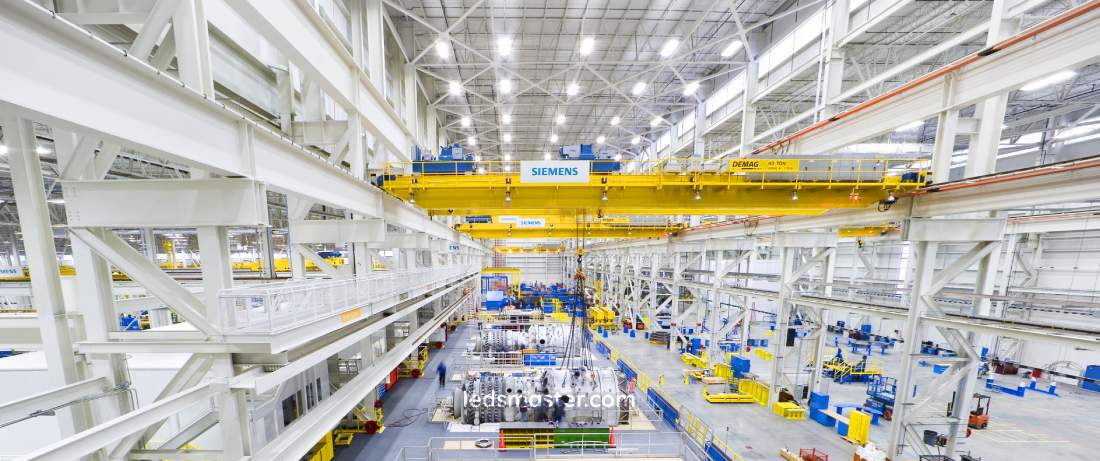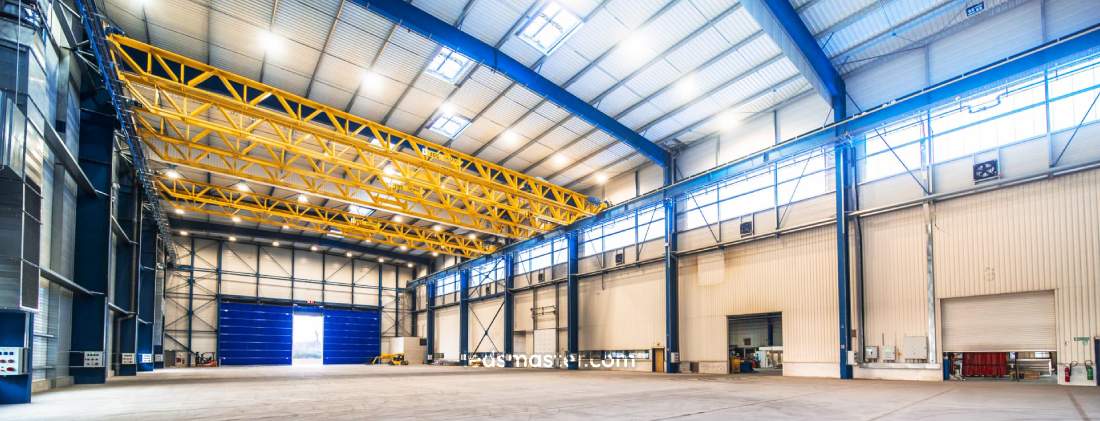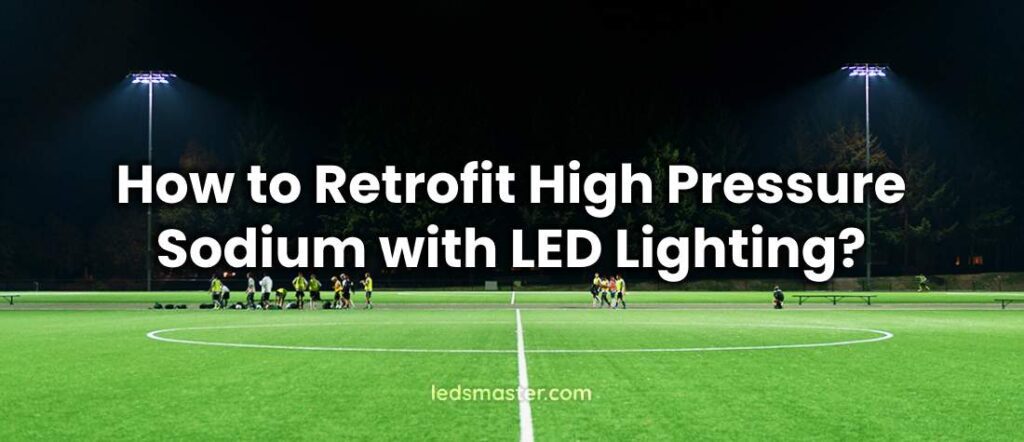Lighting technology has evolved significantly over the past few decades, impacting various industries from commercial spaces to industrial facilities. Historically, High Pressure Sodium (HPS) lamps were widely used due to their efficiency and cost-effectiveness. However, the landscape is changing as industries increasingly adopt LED lighting solutions, driven by advancements in technology and growing environmental awareness.
High Pressure Sodium lighting, once a staple for outdoor and high-bay lighting, is known for its strong light output and long operational life. Despite these advantages, HPS lamps are not without their drawbacks. They are less energy-efficient compared to modern alternatives, have a relatively short lifespan compared to LEDs, and require more maintenance. Besides, HPS lights often produce a harsh, yellowish light that can affect visibility and aesthetics.
Table of Contents
ToggleUnderstanding High Pressure Sodium (HPS) Lighting
What is High Pressure Sodium Lighting?
High Pressure Sodium (HPS) lighting is a type of gas discharge lamp that uses sodium vapor to produce light. The lamp consists of a bulb filled with sodium vapor and a small amount of neon or argon. When an electrical current passes through the gas, it ionizes the sodium atoms, causing them to emit light. This light is predominantly in the yellow to orange spectrum, which is characteristic of HPS lamps.
HPS lighting operates on the principle of electrical discharge. An electric arc passes through the sodium vapor, generating a high-intensity light output. The lamp is designed to start up quickly and achieve full brightness in a relatively short time, making it suitable for applications requiring immediate illumination.
Common Applications and Advantages
HPS lighting is widely used in various applications due to its efficiency and light output. Common uses include street lighting, industrial facilities, and parking lots. The high luminous efficacy of HPS lamps makes them particularly effective for illuminating large outdoor areas where strong, consistent light is necessary.
One of the primary advantages of HPS lighting is its efficiency. HPS lamps produce a high amount of light relative to their energy consumption, making them cost-effective in terms of energy use. They also have a long operational life, which means they do not need to be replaced frequently. The initial investment in HPS fixtures is relatively low, and they perform well in environments where their yellow light is not a significant drawback.
Drawbacks of HPS Lighting
Despite their advantages, High Pressure Sodium lights have several drawbacks that make them less favorable compared to modern alternatives. One major issue is energy inefficiency. While HPS lamps are more efficient than some older technologies, they still consume more power than contemporary LED solutions. This results in higher energy costs over time.
Maintenance is another concern with HPS lighting. Although the lamps have a long lifespan, they are not immune to failure. The need for periodic replacement and maintenance can be both inconvenient and costly. Additionally, the color rendering of HPS lamps is relatively poor, with their yellow light making it difficult to distinguish colors accurately. This can be problematic in applications where accurate color perception is crucial.
From an environmental perspective, HPS lamps have their own set of challenges. They contain small amounts of toxic materials, such as sodium and mercury, which can pose disposal issues when the lamps reach the end of their life. Proper handling and recycling are necessary to mitigate environmental impact, which adds another layer of complexity to their use.

Retrofitting Process Overview
Initial Assessment
Before undertaking a retrofit from High Pressure Sodium (HPS) to LED lighting, it is crucial to perform a comprehensive initial assessment. This step involves evaluating the current HPS setup and identifying any compatibility issues that may arise during the retrofit process. Start by examining the existing fixtures, including their mounting methods and electrical configurations. This will help determine if the current infrastructure can support LED retrofit kits or if modifications are necessary.
Additionally, measuring the existing light levels and coverage is essential. This involves using light meters to record the intensity and distribution of light in the current setup. Accurate measurements will provide a baseline to compare against the performance of the new LED system, ensuring that the retrofit meets or exceeds the existing lighting requirements.
Selecting the Right LED Retrofit Kit
Once the initial assessment is complete, the next step is selecting an appropriate LED retrofit kit. Various types of LED retrofit kits are available, each designed to fit different kinds of fixtures and applications. Common types include LED retrofit bulbs, modular LED retrofit kits, and LED panels. Choosing the right kit involves evaluating several factors:
Light Output
Compare the lumen output of the LED retrofit kit with the existing HPS lamps. The LED solution should provide comparable or improved brightness to ensure the desired light levels are maintained.
Beam Angle
The beam angle of the LED retrofit kit affects how light is distributed. Select a kit with a beam angle that matches the coverage of the existing HPS fixtures to maintain uniform lighting.
Color Temperature
LEDs offer a range of color temperatures, from warm white to cool white. Choose a color temperature that meets the needs of the application and ensures optimal visibility and comfort. While HPS lamps typically emit a warm yellow light, LEDs can provide a broader spectrum of color options.
Preparation for Retrofit
Preparation is key to a successful retrofit. Begin by ensuring safety precautions are in place and gather the necessary tools. This includes turning off the power to the existing lighting system to avoid any electrical hazards. Proper safety gear, such as gloves and safety glasses, should also be used during the retrofit process.
Next, prepare the existing fixtures for the retrofit. This may involve removing old HPS components, such as bulbs and ballasts, and cleaning or modifying the fixtures to accommodate the new LED retrofit kit. Ensure that any electrical connections are properly handled, and verify that the fixture is in good condition to support the new LED components.

Step-by-Step Retrofit Procedure
Step 1: Power Down and Safety Checks
The first and most critical step in retrofitting High Pressure Sodium (HPS) lighting with LED components is to ensure safety. Begin by turning off the power to the existing lighting system at the circuit breaker. This step is essential to prevent electrical shock or damage during the retrofit process.
Once the power is off, perform a thorough inspection to ensure that there is no residual electricity in the fixture. Use a voltage tester to confirm that the electrical connections are completely de-energized. Additionally, wear appropriate safety gear, including gloves and safety glasses, to protect yourself from any potential hazards during the retrofit.
Step 2: Remove Existing HPS Components
With the power safely off, proceed to remove the existing HPS components. Start by carefully disconnecting and removing the HPS bulbs. Most HPS lamps screw into their sockets or are held in place by clips, so gently unscrew or release them as necessary.
Next, turn your attention to the ballasts. HPS lamps require ballasts to regulate the electrical current, and these ballasts are typically housed within the fixture. Disconnect the electrical wires connected to the ballast, and then remove the ballast itself. Make sure to handle all components carefully, as they may be heavy or delicate.
Dispose of the removed HPS components according to local regulations, as they may contain materials that require special handling.
Step 3: Install LED Retrofit Kit
With the old components removed, you can now install the LED retrofit kit. Start by mounting the LED components into the existing fixture. Depending on the type of retrofit kit, this may involve securing LED panels, bulbs, or modules into place. Follow the manufacturer’s instructions for proper installation to ensure a secure fit.
Next, make the necessary wiring and electrical connections. Connect the LED retrofit kit’s wires to the existing fixture’s wiring, ensuring that connections are made according to the electrical standards and the retrofit kit’s specifications. Use wire nuts or connectors as required, and ensure all connections are tight and properly insulated.
Double-check all connections before proceeding to avoid any potential electrical issues or safety hazards.
Step 4: Testing and Adjustments
After the LED retrofit kit is installed and wired, it’s time to test the new system. Restore power to the lighting circuit and turn on the newly installed LED lights. Check the light output to ensure that it meets the desired brightness levels and coverage.
Examine the light distribution to confirm that it aligns with the area that was previously illuminated by the HPS lamps. If necessary, make adjustments to the LED components or their positioning to achieve optimal light coverage and performance.
Verify that the new LED lighting system operates correctly and without any flickering or other issues. If adjustments are required, make them carefully, and retest the system to ensure everything functions as intended.

Cost Considerations
Initial Investment
The initial investment for retrofitting High Pressure Sodium (HPS) lighting with LED technology involves several components: the cost of LED retrofit kits and the installation expenses. LED retrofit kits vary in price based on factors such as light output, design complexity, and brand. Typically, LED retrofit kits for existing fixtures can range from moderate to high costs, depending on their features and quality.
Installation costs can also impact the initial investment. Retrofitting may require professional assistance, especially if electrical modifications are needed or if the retrofit involves complex fixture adaptations. Installation costs vary based on the scope of work, the number of fixtures being retrofitted, and local labor rates. While the upfront cost may seem significant, it is important to consider the long-term benefits and potential savings associated with the retrofit.
Long-Term Savings
One of the primary advantages of switching from HPS to LED lighting is the potential for long-term savings. LEDs are significantly more energy-efficient than HPS lamps, which translates into reduced electricity consumption. LEDs use a fraction of the energy required by HPS lamps to produce the same amount of light, leading to lower energy bills.
In addition to energy savings, LEDs also offer reduced maintenance costs. The long lifespan of LED lights means fewer replacements and less frequent maintenance. HPS lamps, on the other hand, require regular replacements and maintenance due to their shorter lifespan and the potential for ballast failure. By reducing the frequency of maintenance and replacement, LEDs contribute to substantial cost savings over time.
Return on Investment (ROI)
To provide a clearer understanding of how to calculate the Return on Investment (ROI) for retrofitting from High Pressure Sodium (HPS) to LED lighting, let’s illustrate the process with some figures and tables.
Assumptions
| Number of Fixtures | 100 |
| HPS Lamp Wattage | 400W |
| LED Retrofit Kit Wattage | 150W |
| Cost of Electricity | $0.10 per kWh |
| HPS Lamp Replacement Cost | $50 per lamp (including labor) |
| LED Retrofit Kit Cost | $120 per kit |
| Installation Cost | $2000 |
| Average HPS Lamp Lifespan | 20,000 hours |
| Average LED Lifespan | 100,000 hours |
| Maintenance Frequency for HPS | Annual replacement |
Initial Costs
Table 1: Initial Costs Breakdown
| Item | Cost per Unit | Quantity | Total Cost |
|---|---|---|---|
| LED Retrofit Kit | $120 | 100 | $12,000 |
| Installation | – | – | $2,000 |
| Total Initial Cost | – | – | $14,000 |
Annual Energy Savings
Table 2: Energy Consumption and Costs
| Description | HPS | LED | Difference |
|---|---|---|---|
| Wattage per Fixture | 400W | 150W | – |
| Total Power Consumption | 400W × 100 = 40,000W | 150W × 100 = 15,000W | 25,000W |
| Operating Hours per Year | 4,000 hours | 4,000 hours | – |
| Annual Energy Usage | 40,000W × 4,000 hours = 160,000 kWh | 15,000W × 4,000 hours = 60,000 kWh | 100,000 kWh |
| Cost per kWh | $0.10 | $0.10 | – |
| Annual Energy Cost | 160,000 kWh × $0.10 = $16,000 | 60,000 kWh × $0.10 = $6,000 | $10,000 |
| Annual Energy Savings | – | – | $10,000 |
Annual Maintenance Savings
Table 3: Maintenance Costs
| Description | HPS | LED | Difference |
|---|---|---|---|
| Replacement Cost per Lamp | $50 | – | – |
| Frequency of Replacement | Annual | – | – |
| Total Maintenance Cost | $50 × 100 = $5,000 | $0 | $5,000 |
| Annual Maintenance Savings | – | – | $5,000 |
Payback Period
Table 4: Payback Period Calculation
| Description | Amount |
|---|---|
| Total Initial Investment | $14,000 |
| Total Annual Savings (Energy + Maintenance) | $10,000 + $5,000 = $15,000 |
| Payback Period | $14,000 / $15,000 = 0.93 years (approximately 11 months) |
Long-Term ROI
Table 5: Total Savings Over LED Lifespan
| Description | Amount |
|---|---|
| LED Lifespan | 100,000 hours |
| Operating Hours per Year | 4,000 hours |
| Total Years of Operation | 100,000 / 4,000 = 25 years |
| Annual Savings | $15,000 |
| Total Savings Over 25 Years | $15,000 × 25 = $375,000 |
| Total Initial Investment | $14,000 |
| Net Savings | $375,000 – $14,000 = $361,000 |
These figures illustrate the financial benefits of retrofitting from HPS to LED lighting. The initial investment is quickly recouped through significant energy and maintenance savings, leading to substantial net savings over the lifespan of the LED system.
Benefits of LED Lights Over High Pressure Sodium (HPS) Lights
Switching from High Pressure Sodium (HPS) lights to LED lighting offers several compelling advantages:
Superior Energy Efficiency
LED lights stand out for their exceptional energy efficiency compared to High Pressure Sodium (HPS) lamps. LEDs consume significantly less power while delivering the same amount of light. For instance, a 150W LED can effectively replace a 400W HPS lamp, resulting in a remarkable 62.5% reduction in energy consumption. This substantial decrease in power usage not only lowers electricity bills but also contributes to a smaller carbon footprint. By consuming less energy, LED lights reduce the demand on power generation and help decrease overall greenhouse gas emissions, supporting environmental sustainability.
Longer Lifespan
When it comes to operational lifespan, LEDs surpass HPS lamps by a significant margin. LED lights are designed to last up to 100,000 hours, which is substantially longer than the typical 20,000 hours of an HPS lamp. This extended lifespan means that LEDs require far fewer replacements over their lifetime. The reduced frequency of lamp changes not only cuts down on the cost and labor associated with maintenance but also minimizes the disruption of lighting services. In addition, the longevity of LEDs ensures consistent performance and reliability throughout their operational life, making them a more dependable and cost-effective choice.
Reduced Maintenance Costs
The durability and longevity of LED lights lead to considerable reductions in maintenance costs. Unlike HPS lamps, which often need to be replaced annually and require regular upkeep, LEDs have a much longer operational life and are built to withstand various environmental conditions. The infrequent need for replacements translates into fewer maintenance interventions and lower labor costs. For HPS systems, ongoing maintenance and the costs associated with replacing lamps can add up over time. LEDs mitigate these expenses by extending the intervals between maintenance activities and reducing the overall upkeep needed, leading to significant long-term savings.
Improved Light Quality
LED lighting is renowned for its superior light quality compared to High Pressure Sodium (HPS) lamps. LEDs provide higher color rendering index (CRI) values, which means they can reproduce colors more accurately and vividly. This enhancement in color fidelity is crucial for applications where precise color representation is essential, such as in retail environments, museums, or healthcare facilities. Additionally, LEDs offer consistent illumination without the fluctuations often associated with HPS lamps. This consistency improves visibility, reduces eye strain, and minimizes glare, making LEDs ideal for settings that require high-quality, reliable lighting. The ability to provide a more natural and uniform light distribution enhances overall lighting conditions, leading to a more comfortable and effective visual environment.
Better Environmental Impact
LEDs offer a significant advantage in terms of environmental impact compared to HPS lamps. Unlike HPS lamps, LEDs do not contain hazardous materials like mercury, which is toxic and poses a risk of contamination if a lamp breaks. This absence of hazardous substances makes LEDs safer to handle and dispose of. Additionally, LEDs are fully recyclable, further reducing their environmental footprint. Their superior energy efficiency also contributes to environmental benefits by lowering electricity consumption. By reducing the amount of power needed for lighting, LEDs decrease greenhouse gas emissions associated with energy production. This combination of reduced hazardous materials and lower energy use supports broader environmental sustainability goals and contributes to a cleaner, greener planet.
Instant On and Dimmability
One of the key advantages of LED lighting is its ability to provide instant illumination. Unlike HPS lamps, which require a warm-up period to reach full brightness, LEDs turn on instantly, offering immediate light output. This feature is particularly beneficial in applications where prompt lighting is essential for safety or operational efficiency. Additionally, LEDs offer versatile dimming capabilities, allowing for precise control over light levels based on specific needs and preferences. The ability to adjust brightness levels not only enhances visual comfort but also allows for energy savings by reducing light output when full illumination is not required. This flexibility in lighting control further contributes to the overall efficiency and adaptability of LED lighting systems.
Reduced Heat Emission
LED lights are characterized by their low heat emission compared to HPS lamps. While HPS lamps generate significant amounts of heat, which can increase cooling costs and create uncomfortable conditions, LEDs operate at much lower temperatures. This reduction in heat output alleviates the load on air conditioning systems, leading to additional energy savings. Lower heat emission also contributes to a safer working environment, as the risk of heat-related issues and potential fire hazards is minimized. The cooler operation of LEDs enhances their overall safety and makes them suitable for applications where heat accumulation could be a concern.
Lower Total Cost of Ownership
Although the initial investment in LED lighting can be higher than HPS lamps, the long-term financial benefits make LEDs a more cost-effective choice. The reduced energy consumption, longer lifespan, and lower maintenance requirements of LEDs contribute to a lower total cost of ownership. Over time, the savings on energy bills and maintenance expenses offset the initial expenditure, resulting in a more economical lighting solution. This lower total cost of ownership highlights the economic advantages of LED lighting, making it a smart investment for both short-term savings and long-term financial stability.
Common Challenges and Solutions
Compatibility Issues
One of the primary challenges when retrofitting High Pressure Sodium (HPS) lighting with LED technology is compatibility with existing fixtures. HPS fixtures are designed specifically for HPS bulbs and ballasts, which can differ significantly in shape, size, and mounting mechanisms compared to LED components. This mismatch can pose difficulties in fitting the new LED retrofit kit into the existing setup.
To address fixture compatibility issues, start by carefully reviewing the specifications of both the existing fixtures and the LED retrofit kit. Measure the dimensions of the current fixtures and compare them with the dimensions of the LED components to ensure a proper fit. If the existing fixtures are not directly compatible, you may need to use adapter plates or retrofit kits designed to bridge the gap between the old and new technologies.
In cases where fixture modifications are necessary, ensure that any alterations do not compromise the safety or functionality of the lighting system. Consulting with a professional or the retrofit kit manufacturer can provide additional guidance and solutions tailored to your specific fixture type.
Electrical Concerns
Handling electrical concerns is another significant challenge during the retrofit process. LED lights have different electrical requirements compared to HPS lamps, which means that wiring and voltage adjustments may be needed. For instance, LED systems often operate at lower voltages and may require different types of drivers or transformers compared to HPS ballasts.
To manage these electrical concerns, start by thoroughly reviewing the wiring diagrams and electrical requirements provided by the LED retrofit kit manufacturer. Ensure that the power supply and wiring are compatible with the new LED components. If the existing wiring is not suitable, you may need to make modifications or install new drivers and transformers to match the LED specifications.
It is necessary to adhere to all electrical codes and safety standards during this process. If you are not experienced with electrical work, consider hiring a licensed electrician to handle the wiring and ensure that all connections are safe and properly configured.
Light Distribution and Coverage
Achieving optimal light distribution and coverage with LED retrofit kits can also be challenging. LEDs have different light distribution patterns compared to HPS lamps, which may affect how light is spread across the area. Inconsistent light distribution can result in uneven lighting or shadows, potentially compromising the effectiveness of the retrofit.
To address these issues, carefully assess the light output and distribution of the new LED system. Use light meters to measure the illumination levels and ensure that they meet the requirements of the area. If the LED retrofit kit does not provide the desired coverage, consider adjusting the placement of the LED components or selecting a retrofit kit with different beam angles or optical configurations.
In some cases, additional LED fixtures or reflectors may be needed to achieve uniform light distribution. Evaluate the lighting design and make adjustments as necessary to ensure that the new LED system matches or exceeds the performance of the previous HPS setup.
Conclusion
Retrofitting from High Pressure Sodium (HPS) to LED lighting presents a powerful opportunity for enhancing energy efficiency, reducing maintenance costs, and achieving significant long-term savings. With a rapid payback period and substantial environmental benefits, transitioning to LED technology is a smart investment that promises both immediate financial gains and lasting performance improvements. Embrace LED retrofitting to enjoy a more sustainable and cost-effective lighting solution.

